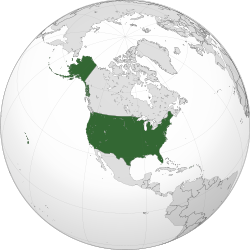United States of America | |
|---|---|
| Motto: "In God We Trust" Other traditional mottos:
| |
| Anthem: "The Star-Spangled Banner" | |
| Capital | Washington, D.C. 38°53′N 77°1′W / 38.883°N 77.017°W |
| Largest city | New York City 40°43′N 74°0′W / 40.717°N 74.000°W |
| Official languages | None at the federal level |
| National language | English |
| Ethnic groups (2020) | By race:
By origin:
|
| Religion (2023) |
|
| Demonym(s) | American |
| Government | Federal presidential republic |
| Donald Trump | |
| JD Vance | |
| Mike Johnson | |
| John Roberts | |
| Legislature | Congress |
| Senate | |
| House of Representatives | |
| Independence from Great Britain | |
| July 4, 1776 | |
| March 1, 1781 | |
| September 3, 1783 | |
| June 21, 1788 | |
| Area | |
Total area | 3,796,742 sq mi (9,833,520 km2) (3rd) |
Water (%) | 7.0 (2010) |
Land area | 3,531,905 sq mi (9,147,590 km2) (3rd) |
| Population | |
2024 estimate | |
2020 census | |
Density | 87/sq mi (33.6/km2) (185th) |
| GDP (PPP) | 2024 estimate |
Total | |
Per capita | |
| GDP (nominal) | 2024 estimate |
Total | |
Per capita | |
| Gini (2023) | medium inequality |
| HDI (2022) | very high (20th) |
| Currency | U.S. dollar ($) (USD) |
| Time zone | UTC−4 to −12, +10, +11 |
Summer (DST) | UTC−4 to −10 |
| Date format | mm/dd/yyyy |
| Calling code | +1 |
| ISO 3166 code | US |
| Internet TLD | .us |
Table of Contents
Understanding Trademarks
Trademarks represent distinctive signs capable of identifying the products or services of an individual or business. They serve as a critical component in the framework of intellectual property rights, ensuring that consumers can differentiate between various entities and their offerings. The primary purpose of a trademark is to protect the reputation of businesses and prevent confusion in the marketplace, thereby fostering fair competition.
There are several types of trademarks recognized within United States law. The most common is a product trademark, which is used to identify goods and ensure that consumers can distinguish them from similar products. Service marks, on the other hand, are specifically designed to identify and distinguish the services provided by one enterprise from those of others. Additionally, collective marks are used by members of a collective group or organization to signify membership and are often employed in industries such as agriculture or artisan crafts. Certification marks serve a similar function, denoting that a particular product or service meets a defined standard or quality, although they are not used by the entity applying for the certification itself.
The legal foundation for trademarks in the United States is anchored in both statutory and common law provisions. The Lanham Act, enacted in 1946, serves as the primary federal statute governing trademarks, providing a broad framework for registration, protection, and enforcement. Under this law, trademark registration offers several advantages, including presumptive ownership and exclusive rights to use the trademark nationwide. Furthermore, common law protections allow trademark owners to assert their rights even in the absence of formal registration, emphasizing the importance of maintaining distinctive signs in the market.
Why You Need a Trademark
Obtaining a trademark is a vital step for any business aiming to protect its brand identity and ensure market competitiveness. A trademark serves as a distinguishing symbol, sign, or expression that identifies and differentiates a company’s goods or services from those of others. This unique identification fosters brand recognition and helps businesses establish their presence in the market.
One of the primary benefits of securing a trademark is brand protection. Registering a trademark provides legal rights to the trademark holder, enabling them to take legal action against unauthorized use or infringement. This legal backing is crucial in maintaining the integrity of the brand and preventing consumer confusion. Moreover, a trademark not only safeguards your brand but also cultivates consumer trust. Customers tend to associate trademarks with quality and consistency, which reinforces consumer loyalty and confidence in the products or services offered.
Trademarks also enhance the value of a business’s intellectual assets. A well-known trademark can significantly increase a company’s worth, offering leverage in negotiations, licensing agreements, or business sales. For instance, some companies have successfully monetized their trademarks through licensing agreements, allowing others to use the mark while generating revenue. Conversely, businesses that fail to protect their trademarks may face severe repercussions, including costly disputes. A notable example is the “Apple” trademark case, where Apple Inc. faced challenges with companies trying to capitalize on its name, leading to prolonged legal battles that showcased the importance of trademark protection.
In summary, a trademark offers numerous benefits, including brand protection, consumer trust, and enhancement of a business’s intellectual asset value. Its importance in distinguishing a business in a competitive market cannot be overstated. Thus, investing in a trademark is not merely a legal requirement but a strategic business decision that can yield significant long-term benefits.
Preliminary Research Before Filing
Before embarking on the process of filing a trademark application in the United States, it is crucial to conduct thorough preliminary research. This essential step assists applicants in determining the availability of their desired trademark and prevents future legal disputes. The first area of focus should be the United States Patent and Trademark Office (USPTO) database. Utilizing the USPTO’s Trademark Electronic Search System (TESS) allows applicants to search for existing trademarks that may conflict with their proposed mark. Performing a search for similar or identical trademarks can help in identifying potential issues early in the process.
Beyond the USPTO database, applicants should explore other online resources that can provide valuable insights. Websites like state trademark databases, domain registration sites, and business registries can uncover conflicts that are not immediately evident in the federal database. For instance, a trademark could be registered at the state level while not being federally registered, yet still pose a risk of confusion among consumers. Thus, it is advisable to broaden the search to include various platforms to gauge the availability of the trademark comprehensively.
Another important factor in preliminary research is assessing whether the desired trademark is distinctive and not likely to cause confusion with existing marks. Trademark law protects not only registered trademarks but also those in use in commerce. Conducting a comprehensive search and analysis of potential trademarks can save applicants considerable time and resources in the long run, helping to avoid an application that may be rejected due to conflicts. Understanding these nuances of trademark searching is fundamental before proceeding with the formal filing process, ultimately contributing to a stronger trademark application.
Identifying the Right Trademark Class
When it comes to filing a United States trademark application, a crucial aspect is identifying the appropriate trademark class. The United States Patent and Trademark Office (USPTO) utilizes an international classification system known as the Nice Classification System. This system categorizes goods and services into 45 distinct classes, making it easier for applicants to determine where their products or services fit.
Selecting the correct trademark class is vital for the successful registration of a trademark. Each class corresponds to a specific category of goods or services, which allows the USPTO to organize and process applications more efficiently. Misclassifying your goods or services can lead to application delays, rejections, or extended legal challenges, making it imperative to conduct thorough research before submitting your application.
To identify the suitable trademark class for your application, you can begin by examining the USPTO’s Acceptable Identification of Goods and Services Manual. This comprehensive guide lists examples of acceptable descriptions for a wide range of products and services, enabling applicants to pinpoint the most relevant classes. Additionally, understanding the nature of your goods or services will help narrow down the options, as each class has specific criteria that define what is included.
It is not uncommon for businesses to find that their products or services may fall under multiple classes. In such cases, it is essential to file separate applications for each class to ensure full protection across all relevant categories. Moreover, being concise yet descriptive in your identification can facilitate the examination process, ultimately leading to a smoother application journey.
In essence, taking the time to accurately identify the right trademark class is a crucial step in the trademark application process. A correct classification not only enhances your chances of approval but also provides robust protection for your brand in the marketplace.
Preparing the Necessary Documentation
When embarking on the process of filing a trademark application, it is essential to gather all necessary documentation to ensure a smooth submission. The foundation of this process begins with the completion of the trademark application form, which typically requires detailed information regarding the applicant, the desired trademark, and the goods or services associated with it. This form can usually be found on the United States Patent and Trademark Office (USPTO) website and must be filled out meticulously to reflect accurate details.
In addition to the application form, applicants are required to provide at least one specimen that demonstrates the actual use of the trademark in commerce. Specimens can vary depending on whether the trademark is in the form of a word mark, service mark, or design mark. For instance, for a word mark, an appropriate specimen could be a screenshot of the trademark displayed on a website or a label on a product. Conversely, a design mark may necessitate a visual representation showcasing the graphical elements within actual usage. This clear demonstration is crucial for the examination of the application by the USPTO.
Furthermore, it is crucial to provide a detailed description of the goods or services associated with the trademark. This section must clearly articulate the nature and scope of the goods or services being offered, ensuring that prospective trademark protections are apparent and aligned with the intended usage. Accurately delineating this information helps in avoiding potential conflicts with existing trademarks and assists the USPTO in its examination process.
The representation of the trademark itself is also vital. Applicants must choose between a word mark, which safeguards the brand name, or a design mark, which protects logo elements. The choice will depend on the character of the brand and how it is perceived by consumers. Each type of representation comes with its distinct requirements, and ensuring compliance is essential for a successful application.
Filing the Trademark Application
The process of filing a trademark application with the United States Patent and Trademark Office (USPTO) can be navigated smoothly by adhering to specific steps. Initially, applicants must determine the type of trademark they intend to file, which can include a standard character mark, a stylized/design mark, or a sound mark. Once you have established the type, you can proceed to the application process.
There are two primary methods for filing a trademark application: online and paper filing. The USPTO strongly recommends using the online filing system known as the Trademark Electronic Application System (TEAS) due to its efficiency and lower costs compared to paper applications. To begin the online filing process, you need to create an account on the USPTO website. Once logged in, you can select the appropriate TEAS form based on your trademark type and specific needs. The forms available include TEAS Plus, TEAS Standard, or TEAS Reduced Fee (RF), each varying in requirements and costs.
The filing fee is essential to consider, as it varies depending on the application type and the number of classes of goods or services covered. The fees can range from $250 to $350 per class when filing online. Ensure to check the current fee structure on the USPTO website, as rates may change. During the application process, accuracy is paramount; any inconsistencies or errors can result in processing delays or outright refusals. It’s crucial to double-check all entries, including the trademark description and the goods/services classifications, for any potential mistakes.
After submitting the application, you will receive a confirmation receipt. This document will include your application serial number, enabling you to track the status of your trademark request through the USPTO’s online status check tool. Careful adherence to these steps will greatly enhance the likelihood of a successful trademark registration.
Understanding the Examination Process
Once a United States trademark application is submitted to the United States Patent and Trademark Office (USPTO), it enters the examination phase, which is a critical part of the trademark registration process. During this stage, an examining attorney at the USPTO reviews the application to ensure it complies with all legal requirements and does not conflict with any existing trademarks. This examination is vital to maintain the integrity of the trademark registry and to protect consumers from confusion regarding the source of goods or services.
The examining attorney will first check if the application meets the formal requirements set by the USPTO, including clarity of the trademark, appropriate classifications, and complete filings. In addition to assessing compliance, the attorney conducts a thorough search for possible conflicts with registered trademarks that could lead to consumer confusion or potential dilution. This step is crucial, as it helps ascertain whether the proposed trademark can coexist with existing marks without infringing upon the rights of others.
Should the examining attorney identify any issues during their review, they will issue an office action. An office action is an official document outlining the deficiencies or objections concerning the application. These may pertain to the distinctiveness of the trademark, potential conflicts with existing registrations, or failure to provide necessary documentation. Responding to an office action is imperative; applicants typically have six months to address the concerns raised. Failing to respond within this timeframe may result in the application being abandoned.
In responding to an office action, it is essential to provide clear and thorough explanations or to amend the application as necessary to resolve the objections. This could include submitting arguments against the objections or revising the trademark’s description, thereby facilitating its approval. By understanding the examination process and the role of the USPTO examining attorneys, applicants can navigate this critical phase of trademark registration more effectively. This proactive approach will streamline the application process and improve the chances of successful registration.
Responding to Office Actions
When navigating the complexities of the United States trademark application process, one critical aspect to be aware of is the issuance of office actions by the United States Patent and Trademark Office (USPTO). An office action represents a formal communication from the USPTO examining attorney, outlining issues with the trademark application. These actions can be classified into two main categories: non-final and final. Understanding these classifications is vital for applicants aiming to secure trademark protection.
Non-final office actions typically indicate that the examining attorney has identified problems that can be rectified through amendments or additional documentation. For instance, these may involve issues of descriptiveness, likelihood of confusion with existing marks, or lack of distinctiveness. In such instances, applicants are usually given a six-month period to respond adequately. If the applicant fails to respond within this timeframe, the application may be deemed abandoned.
Conversely, a final office action signals that the examining attorney believes the issues remain unresolved after the applicant’s previous response. While the timeline for responding to a final office action is generally the same—six months—the stakes are higher, as further chances for amendment are limited. Applicants who receive a final action may consider filing a Request for Reconsideration or appealing the decision to the Trademark Trial and Appeal Board (TTAB).
To effectively respond to any office action, it is crucial to carefully analyze the concerns raised and prepare a well-structured response. This may include amending the application to better align with the USPTO’s requirements or supplementing the application with additional documentation that supports its registrability. Maintaining clear communication and addressing each point mentioned in the office action will enhance the probability of a favorable outcome. As the trademark application process unfolds, ensuring compliance with USPTO standards will significantly influence an applicant’s success in securing a trademark registration.
Maintaining Your Trademark Registration
Once a trademark is registered, maintaining that registration is essential to protect the brand identity and exclusive rights granted by the United States Patent and Trademark Office (USPTO). To keep a trademark active, the owner must meet ongoing requirements, including the submission of maintenance documents at regular intervals.
The two primary documents that trademark owners are responsible for are the Declaration of Use and the Renewal Application. The Declaration of Use, also known as Section 8 filing, must be submitted between the 5th and 6th year following registration. This document asserts that the trademark is still in use in commerce as specified in the original application. It is vital to include specimens of current use to demonstrate ongoing branding efforts, thereby affirming the legitimacy of the trademark.
Furthermore, the Renewal Application, also referred to as Section 9 filing, is required every ten years. This filing is imperative to maintain trademark protection, as failure to submit it may result in cancellation of the registration. Should a trademark owner neglect these responsibilities, they risk losing their rights to the mark, potentially allowing others to use or register similar marks.
To effectively monitor and protect one’s trademark, it is advisable to conduct periodic searches for potential infringements. Employing trademark watch services can help alert owners to unauthorized use of their marks, safeguarding their brand reputation and legal rights. Additionally, notifying infringers promptly can deter potential violations before they escalate.
In summary, maintaining a trademark registration is not a one-time effort; it requires ongoing attention and compliance with set regulations. Staying active in monitoring the trademark and fulfilling necessary filing requirements will ensure continued protection and viability in the marketplace.




